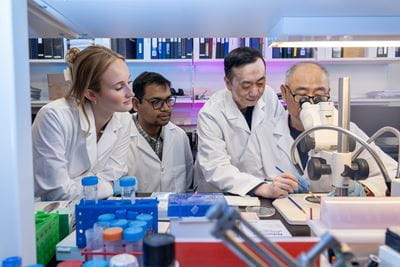
The laboratory of Xiang Gao, PhD, focuses investigations on the mechanisms of traumatic brain injury (TBI). His research is threefold: to find an effective way to mitigate, or even prevent, cell death and dendritic/synaptic degeneration post TBI; to explore potential therapeutic interventions for repairing damaged neural circuitries; and to study the molecular mechanisms underlie immune response and neuroinflammation post-trauma.
An estimated 2.8 million incidences of TBI occur within the United States annually, and the injury contributes to a substantial number of trauma-related deaths and also permanent disabilities in survived patients that has a devastating impact on them and their families. Unfortunately, there is no effective treatment for this disease. Preventing cell death—stopping or blocking damage from the beginning of insult—is the most effective way to halt TBI. Neuronal excitotoxicity caused by robust increase of glutamate post-trauma is a primary area of interest for the Gao Lab. A glutamate signaling pathway has been proven to play a critical role in neuronal death after TBI. However, it isn’t fully understood. The Gao lab is furthering this study, and, for the first time, morphologically revealed extensive dendrite and spine degeneration in spared neurons after TBI. Live imaging using a cutting-edge thinning-skull technique and combined with 2-photon confocal microscopy further confirmed this phenomenon in vivo. The timing of dendritic and synaptic degeneration correlated with functional loss and suggested it may have a major contribution to the deficit. Moreover, dendritic and synaptic degeneration happened in a comparable later phase, about 24 hours after injury in an animal model, allow us to practically prevent it, especially in the clinic.
The Gao Lab designed a stem cell niche in the cortex using an in vivo reprogramming method. Damaged neural circuitries directly result in associated neurological disorders. Stem cells could be affected by their local environment to generate sufficient neurons to fill the cavity in the injured cortex. This method may create a potentially therapeutic application for curing TBI. Other than regenerating new neurons to compensate the loss, directly targeting and managing function-related neural circuitry and improving functional outcomes seems a promising novel intervention.
Overwhelming evidence has revealed that TBI triggers sterile neuroimmune and neuroinflammatory responses that can have both detrimental and beneficial effects. While appropriate acute and transient neuroimmune responses facilitate the repair and adaptation of injured brain tissues, prolonged and excessive neuroinflammatory responses may accelerate TBI brain damage. The mechanisms that control the intensity and duration of neuroimmune and neuroinflammatory responses in TBI largely remain elusive. The Gao lab plans to study the role of immune checkpoints in the regulation of neuroimmune and neuroinflammatory responses in the brain in vivo.
The projects in the lab are designed to study the molecular mechanisms underlying pathologies after TBI. This work will lead to identifying vital targets for clinical studies with a team of neurosurgeons at IU School of Medicine.

